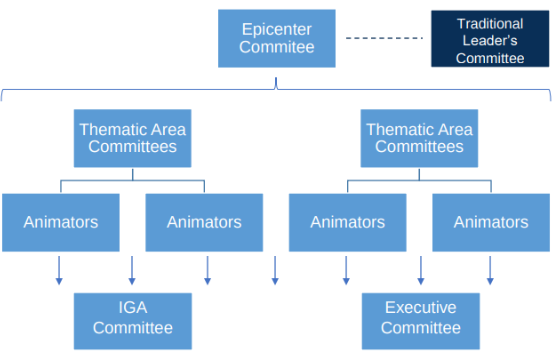Before providing the details of how training courses should be implemented, it is essential that implementers have a good understanding of the Epicenter Strategy as a whole. This section gives an overview of what the Epicenter Strategy is, then explains the key roles involves in terms of both the implementation officers and the community themselves, as well as other partners, such as local Government.
Strategy Overview
GENDER-FOCUSED, COMMUNITY-LED DEVELOPMENT IN RURAL AFRICA
Film 1: The Epicenter Strategy Overview:
The Hunger Project’s Epicenter Strategy unites 10,000 to 15,000 people in a cluster of villages to create an ‘Epicenter’, or a dynamic center where communities are mobilized for action to meet their basic needs. This holistic strategy takes them on a path to sustainable self-reliance through four distinct phases over a period of about five to eight years. During this time, individuals build the confidence to become leaders of their own development, and communities come together to unlock a local capacity for change.
Epicenter’s are located in communities that have been identified, in partnership with local Governments, as being in serious need and ready to take self-reliant action to meet those needs. Implementation of the Epicenter Strategy happens over four phases, namely; Mobilization, Construction, Program Implementation and Transition to Self-Reliance (see Section A3), which take place over period of around five to eight years.
The Epicenter building itself is an L-shaped building that houses various service centers for the community, such as a clinic, preschool and rural bank. It acts as a central hub for the various development activities that take place under the strategy.
Click the image below to see the full Theory of Change!

These activities fall under twelve thematic areas, namely;

Figure 2: Thematic Areas
- Also known as Vision, Commitment and Action
- Also known as Village Savings and Loans
- Also known as purely ‘Education’
Implementing Officers
Three types of Implementing Officers are involved in the Epicenter Strategy training courses, overseen by the Head of Programs and Country Director. The roles of the three officers responsible for training courses are described below:
Sector Specialists
Sector Specialists (SS) are responsible for the overall management of one or more of the different programs that make up the Epicenter Strategy. In partnership with the Epicenter communities, SS set targets for each thematic area. The community give insights into what they think is achievable in the period and this ensures the community own the targets and commit to achieve them. The SS on the other hand gives insights to what was achieved for the same indicator in the previous years. The SS support the community in the implementation program activities to help ensure these targets are met. For the SS, this involves allocating budgets, scheduling and delivering training courses, liaising with the other implementing staff, Government and other Non-Government Organisations (NGOs) to plan project activities and participating in Local, Regional and National level coordination meetings for their thematic areas. SSs, in conjunction with the Head of Programs and Country Director help to coordinate the different program activities to ensure an orderly schedule is being followed.
Epicenter Project Officers
Epicenter Project Officers (EPOs) live and work within the community full time, residing in one of the villages in the Epicenter catchment area and participating in the full range of Epicenter activities. The EPOs work with the community to set their own monthly, quarterly and annual objectives (e.g. number of workshops held, number of people attended). This involves working closely with the Epicenter Committees (see Part One, Section 1.3).
EPOs also conduct a range of training courses, either in conjunction with SSs or external facilitators, or by themselves. They are present at all training sessions, even if not facilitating. They will also conduct half-day informal training sessions when necessary. They are responsible for notifying and mobilizing the community for different training courses and activities that happen at the Epicenter. EPOs also conduct monthly, quarterly, biannual and annual review meetings with Epicenter Committees, where they report on activities, compile and submit reports. EPOs also help manage and support the village ‘animators’ (see Part One, Section 1.3), monitoring and encouraging them in their volunteer roles. EPOs leave the community once it has achieved ‘self-reliance’.
District Liaison Officers
District Liaison Officers (DLOs) carry out a similar role to EPOs, with the key differentiation that they are responsible for several Epicenters in a district and are based at the district center rather than within the Epicenter community. The DLOs represent the Epicenter at a district level, participating in district committees, liaising with local Government and other NGOs operating in the area. They are responsible for identifying the needs of communities in their districts and the corresponding training courses and activities that are required to meet them. Like EPOs, DLOs carry out several different training courses themselves and organize training courses to be delivered by Government staff and other external facilitators.
Figure 3: Implementing Officers

Community Partners
Film 3: Animators and Committees:
The Epicenter Strategy is a community-led development approach. In line with this approach, members of the community are known as ‘partners’ rather than ‘beneficiaries’. The key community partners in implementing the strategy are volunteers, known as ‘animators’. The animators also form the various thematic area committees that manage the Epicenter’s operations.
Animators
Animators are volunteers from the community, selected by the community to serve them in different thematic areas of the Epicenter Strategy. Local leaders meet and identify people with the right characteristics from among their community to become animators. The personal requirements of animators are that they should be a confident public speaker, a good role model, influential in the community, willing and able to volunteer their time and able to read and write. The animators work closely with the EPOs on a daily basis, who provide them with information, coordination and support.
Animators are recruited and trained for each thematic area. The two key roles of the animators are to mobilize their community to carry out development activities and to disseminate information in their thematic areas. The Epicenter Strategy adopts a ‘training of trainers’ methodology, where animators are trained by specialists, either from the implementing organization or relevant Government department, so that they are able in turn to go and train the wider community through village-based workshops (see Part Two, Section 1.4).
Given the vital importance of Animators in implementing the Epicenter Strategy, these Animator Training Courses are the primary focus of this toolkit.
Animators from each thematic area elect a committee from among themselves to manage the activities under their program. The thematic area committee choose from among themselves one person to be trained as an M&E animator, this is typically the committee secretary. This is because minute taking (the main role of secretaries) is included in the M&E training. If the secretary is not willing/able, then the EPO suggests the best person for the job from the other committee members. Therefore, all thematic areas must have their animators recruited before M&E Animator selection and training takes place.
Committees
The Epicenter has an overall leadership committee known as the Epicenter Committee. Members are drawn from village clusters (with typically three villages per cluster), with one member from each cluster. The community are introduced to the Epicenter concept and sensitized on the need for good leadership by the SSs who make intensive visits to the community in the early phases of implementation. Each village cluster then nominates members from among themselves and informs the EPO. These committees have two-year terms and hold quarterly accountability meetings. Epicenter Committees must have equal numbers of men and women as members.
Working under the leadership committee there are committees made up of animators from each thematic area. The animators in each thematic area elect a committee from among themselves to oversee and monitor their program implementation activities.
When an Epicenter is ready to transition to self-reliance, the most committed animators are chosen to form an Executive Committee, who will manage the transition. Epicenter may also form an Income Generating Activity (IGA) committee to manage any income generating projects that have been started to ensure financial sustainability.
| “Committees are the ones that drive the development activities, so they need to have good leadership, and there must to be an overall leadership committee they are accountable to.” Abridged Partner View, shared at Champiti Epicenter, Malawi |
There is also a committee of Traditional Local Leaders (in Malawi known as ‘Traditional Authorities’). In Malawi for example, this committee is typically made up of the Village heads (VHs) from all participating villages, and Group Village Heads (GVHs), who are responsible for several villages, where appropriate. This committee is responsible for managing conflict between the Traditional Local Leaders and mobilizing their communities.
Figure 4: Community Partners

Other Partners
Government
Implementing officers and community partners need to work closely with and coordinate different parts of Government that deliver training courses and services to the Epicenter communities. Local and (if appropriate) national level Government officials should be involved from the very start of the strategy implementation. When a location for an Epicenter is being chosen, Government staff will provide socio-economic profiles to assist the implementing organization in selecting the communities in most need of assistance. Local Government should be consulted and involved at all stages to ensure their ongoing cooperation with Epicenter activities and to ensure the long-term sustainability of community development activities initiated under the strategy.
| “If there is not proper coordination with the Government, they can frustrate your efforts” Sector Specialist |
Traditional Local Leaders
Another key aspect of the strategy is that it must work closely with Traditional Local Leaders in the communities. The importance of this depends on the cultural significance of these authorities in the location the strategy is being implemented. In Malawi for example, this is seen as being very important:
| “Chiefs are the owners of the project, since the chiefs ‘own’ the people” Sector Specialist |
Traditional Local Leaders are involved from the very start and all the way through the implementation phases. Implementing Officers visit VHs before any other workshops take place in Phase One to explain the Epicenter Strategy and encourage the participation of them and their community. A VH’s committee is formed and identifies members from their communities to be trained as animators, in conjunction with EPOs. It is important for Implementing Officers to communicate regularly with VHs and to be approachable and attentive to their views and concerns. VHs should be informed about the development activities going on in their communities and the tasks assigned to animators, so that they can monitor, encourage and support their efforts.
| “We did not think that ending hunger was possible and we have seen other NGO’s operating in this area without success, but the chief’s support encouraged us to participate.” Abridged Partner View, shared at Champiti Epicenter, Malawi |
Other NGOs
There may be multiple other NGOs working in the same communities as the Epicenter Strategy on development activities. Some of their activities may be complimentary, others may be conflicting. Either way, it will be beneficial when implementing the Epicenter Strategy to coordinate with these organisations. This may take place though a local Government Development Committee (in Malawi known as the District Development Committee) or may require the implementing staff to build networks with these organisations individually.
| Adapting to The Local Context When the Epicenter Strategy is first introduced into a new country, it is essential that the implementing organization has a proper understanding of local and national governance structures. This includes traditional leadership, civil society and Government structures. Partnering effectively with these structures is essential to the success of the Epicenter Strategy. Click here for further guidance on this subject. |
